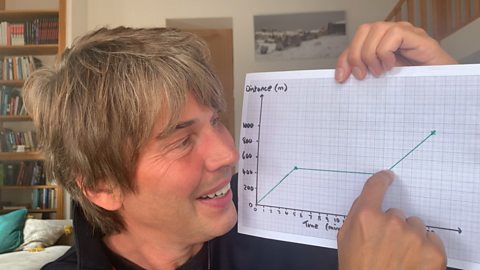I want to talk about forces. So, what are forces?
Well forces cause things to change, and a beautiful example of that is Newton's first law of motion. It says that things stay still or carry on moving at a constant speed in a straight line, unless acted upon by a force.
Now, the first bit of that is, I suppose, really obvious. If you don't do anything to something, it stays where you put it.
The second bit is actually not so obvious. In fact, if you go back to ancient Greece, Aristotle, who was a very clever person, thought that if you stop pushing on something that it comes to a halt. It stops moving.
It took until Galileo's time, in the 1600s, to realise that isn't true. The reason that we think it's true is if you stop pushing a chair across the floor, it stops, is because there is always another force acting as well. Not only the push, but also the friction between the chair legs and the ground.
If you could push the chair, give it a shove, on a surface that was completely frictionless, let's say a perfect ice rink, then you kind of know that the chair would carry on drifting or moving across the ice, at pretty much constant speed, because there are pretty much no forces acting.
In this short video Professor Brian Cox describes NewtonŌĆÖs First Law of Motion, focusing on the challenging concept of the effect of a force on a moving object.
Common observations are used to explain the law and to explore why it is often counter-intuitive.
The video highlights how scientific thinking about forces has changed over time, with reference to the ideas of Aristotle and Galileo.
Teacher Notes
Points for discussion:
Students will usually believe that if you stop pushing a moving object, it will come to a stop, making the second part of NewtonŌĆÖs First Law counter-intuitive. This video focuses on that misconception, explaining why we might hold that belief (because we are constantly observing the effects of friction on a moving object) and then uses an example to correct the misunderstanding.
Although at KS3 NewtonŌĆÖs First Law may not be mentioned explicitly, the impact of forces and friction on objects and how they cause objects to move or stop are explored.
Suggested activities:
This video could be used as an introduction to NewtonŌĆÖs First Law or to dispel any myths and misconceptions about forces and friction that may come up when introducing the topic.
At KS4, the video could used to revise concepts already learnt before starting a forces and motion topic.
This video could be used as in introduction to a demonstration of the effects of friction. For example, ask students to think about the movement of the puck on an air hockey table and link that to friction.
An air track could be used to demonstrate movement of an object in an environment with reduced friction, and students can observe how objects appear to move more easily.
As the video introduces ideas from Aristotle and Galileo, as well as from Newton, students could explore the contributions and discoveries of each of these scientists from history.
At KS4, the video could help to ensure a sound understanding of NewtonŌĆÖs First Law before moving on to explain motion.
Curriculum Notes
Suitable for KS3, Combined Science and Physics GCSE in England, Wales and Northern Ireland and at National 4 and 5 in Scotland, and Cambridge IGCSE Physics

HookeŌĆÖs Law. video
An explanation of HookeŌĆÖs Law using a spring as an example and showing how overstretching a spring leads to a non-linear relationship between force and extension.

An introduction to the speed equation. video
An introduction to the speed equation, illustrating its logic using the example of a journey from home to school.

The importance of checking mathematical answers. video
A reminder to always sense-check mathematical answers in physics, using a speed calculation as an example.

Average speed. video
An introduction to average speed and how to use a simple distance-time graph to calculate it.

Relative speed. video
An explanation of the concept of relative speed and how to calculate the relative speeds of two vehicles going in the same direction and in the opposite direction.
